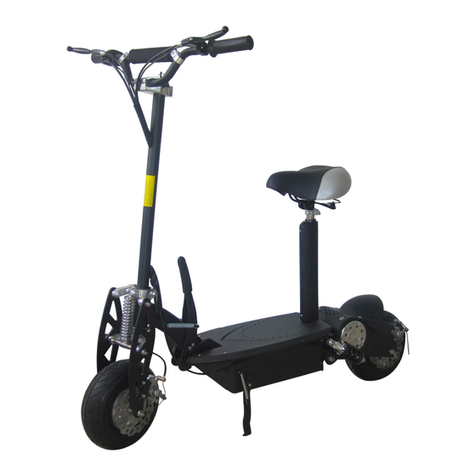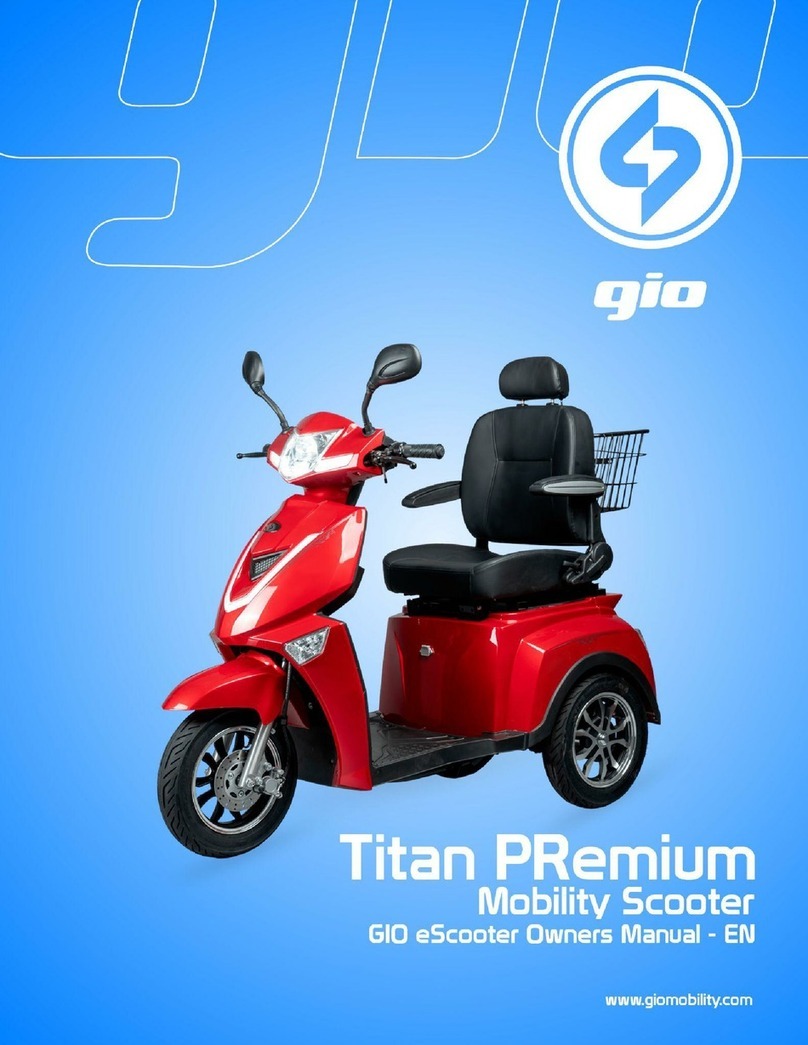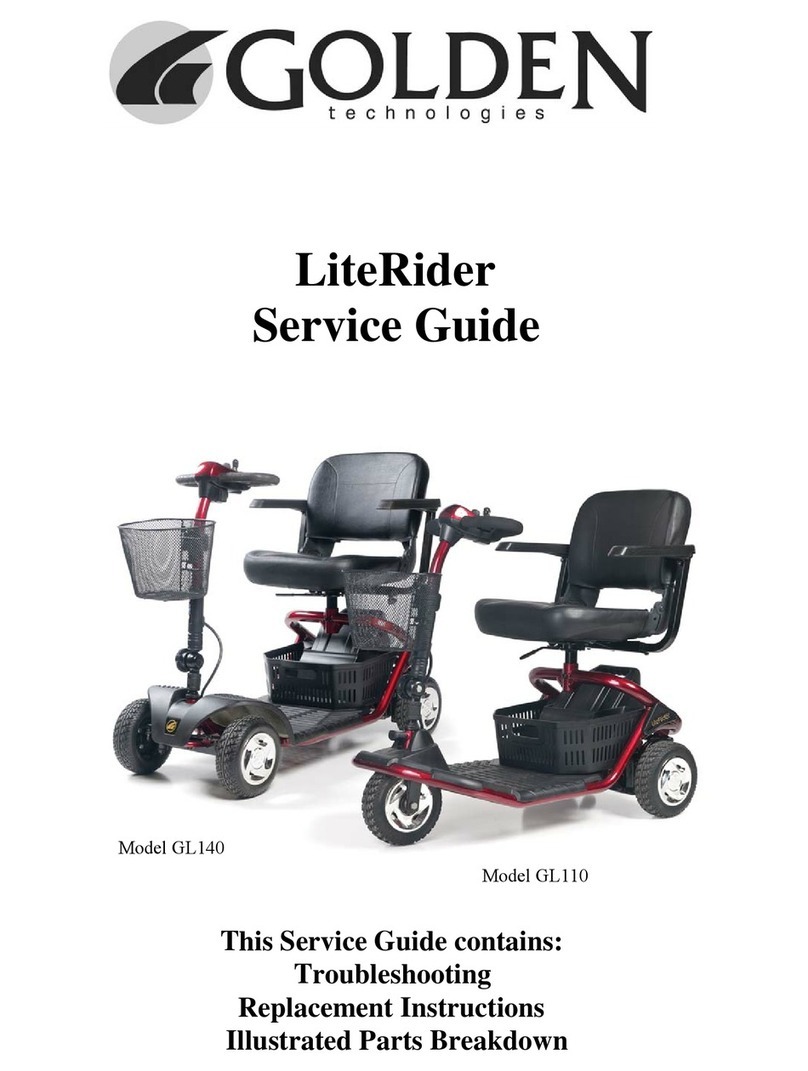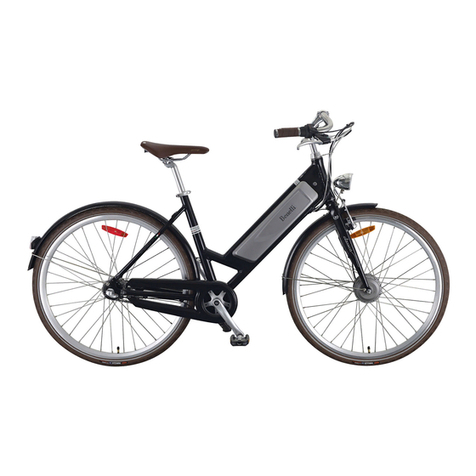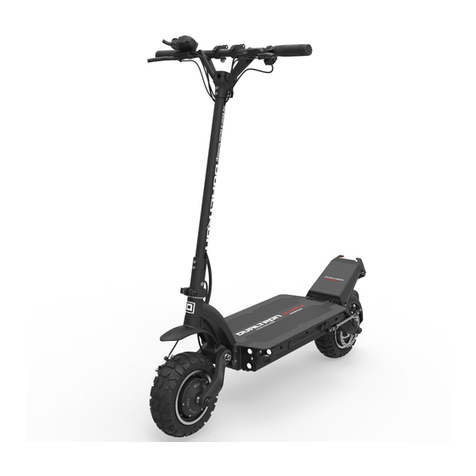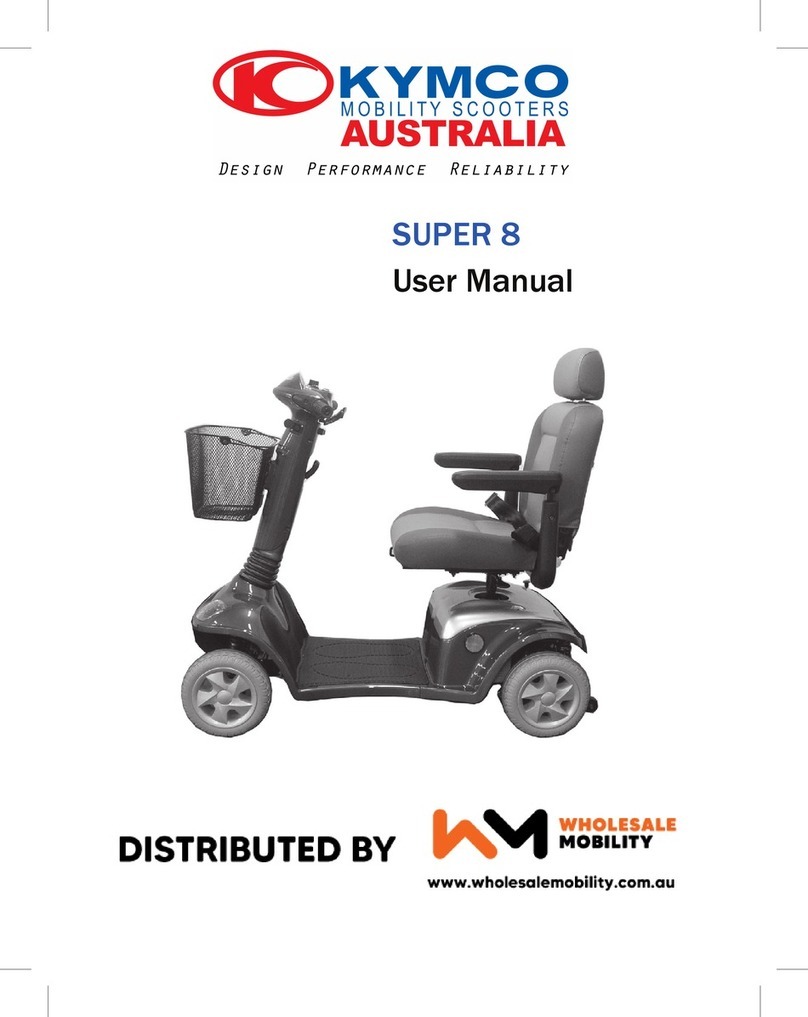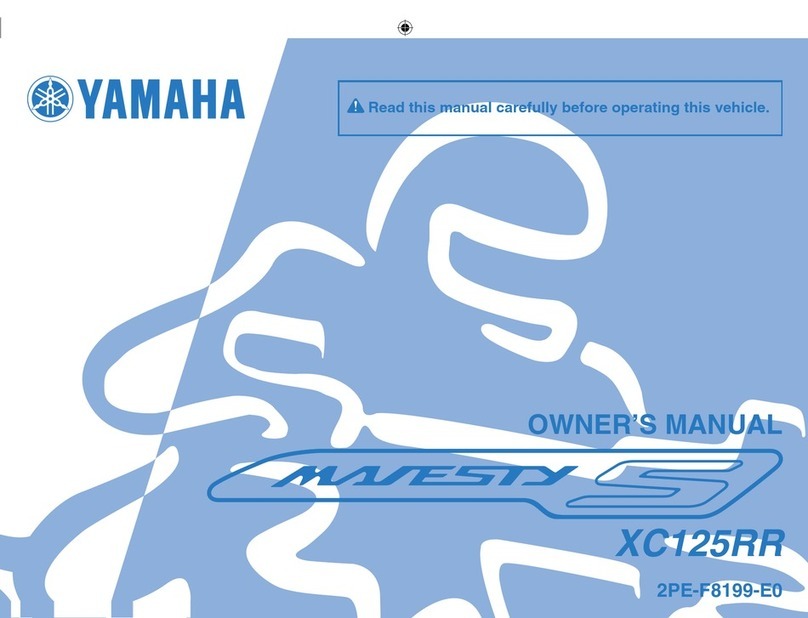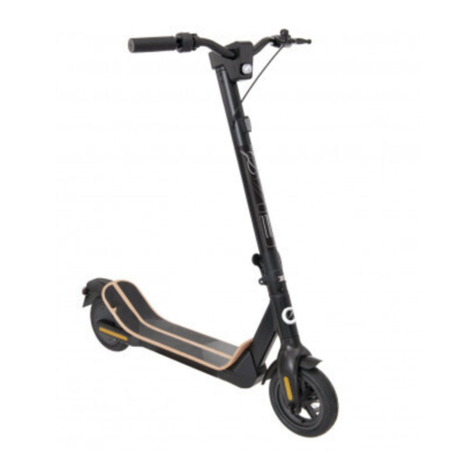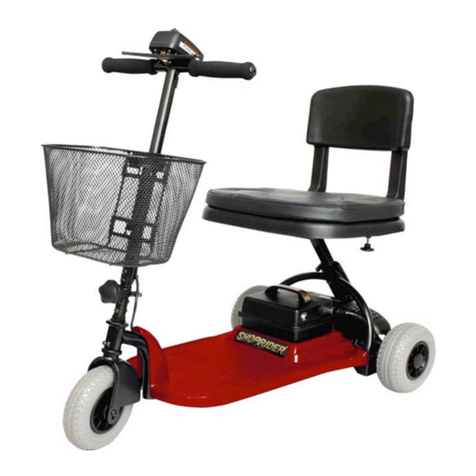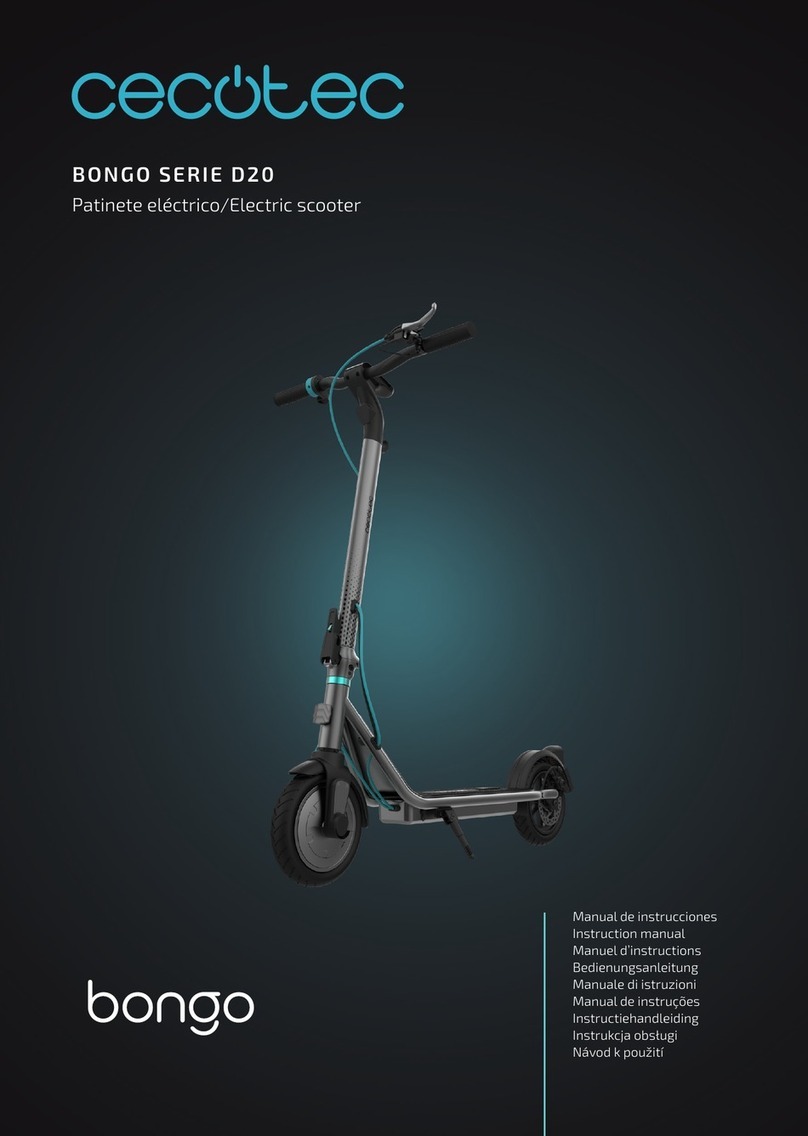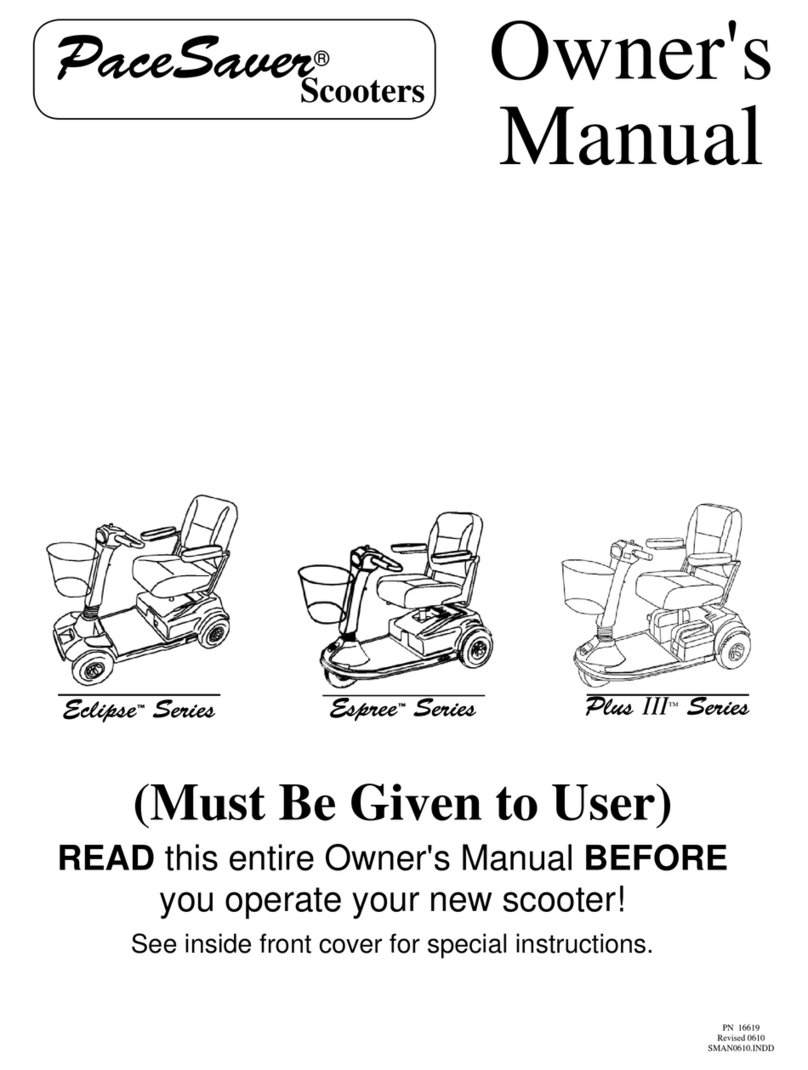gio Royale User manual


PLEASE INSPECT YOUR GIO ELECTRIC R E-SCOOTER UPON
ARRIVAL AND REPORT ANY DAMAGES THAT MAY HAVE
OCCURRED DURING SHIPPING
⚠
Before operating, please read this manual carefully and familiarize
yourself with GIO Electric scooter components and how they function
1. Please observe all local traffic laws. Remember: ignorance of the law is no excuse.
2. Please check both front and rear brakes before operating and adjust if necessary.
Always allow distance for braking especially in wet, slippery conditions
3. Check often for loose fasteners, especially the wheel nuts, handlebars and saddle
fasteners.
4. Twist the right side handle grip to go, and combine both front and rear brake levers to
stop.
5. For safety when charging please have both the charger and bike in a well-ventilated
area.
6. Avoid disassembling the entire bike or wiring without proper knowledge.
7. Please be responsible and dispose of all old batteries through a local battery recycler.
8. Illustrations/images in this manual may differ from the final product.
9. If you have any concerns or questions in regards to you e-Scooter please contact
GIO Electric Customer Service
1

Table of Contents
Safe Operations Guide 3
Overview 4
Scooter Assembly
Components 4
Mirror installation 5
Front wheel installation 5
Connecting the battery 7
Scooter & Control Diagrams 8
Operating Controls and Security Features
Ignition switch 10
Circuit breaker 10
Throttle 10
Brakes 10
Lights and turn signals 11
Kickstands 11
Alarm and security 11
Maintenance and Care
Cleaning 12
Lubrication 12
Schedule 13
Battery Care 13
Component Specific Information
Charger & Charging your scooter 14
Motor 15
Controller System 15
Brakes 15
Storage 15
Initial and ongoing adjustments
Brakes adjustment 16
Tires Pressure 16
Troubleshooting 17
Wiring Schematic 18
VIN / Serial number Location 18
2

Safe Operations Guide
Do not ride while using headphones/cell phones as they mask traffic sounds and
emergency vehicle sirens, and cause distracted driving which can lead to accidents
Never consume drugs or alcohol before or while operating your GIO electric scooter,
they can impair your judgment and reaction time.
Never stand on a scooter whether moving or not.
Always keep both hands on the handlebars and both feet on the footrest during
operation. Always be alert to your surroundings.
Do not turn at excessive speeds or make sudden or sharp turns.
Never operate your GIO electric scooter without wearing an approved helmet that fits
properly.
Before riding your GIO electric scooter, check throttle control and brakes for proper
operation.
Always inspect your GIO scooter before each use to make sure it is in safe operating
condition. Check for loose screws, nuts, bolts, parts, brakes, drive chain, etc.
Always follow the inspection and maintenance procedures described in this manual.
Always maintain proper tire pressure as described in this manual. Type of tire and
inflation can affect scooter handling
Do not operate near flammable liquids or materials Never attempt to repair when power
is on
⚠
DO NOT MAKE ANY ALTERATIONS OR MODIFICATIONS TO THIS GIO
E-SCOOTER OR ADD ANY PARTS NOT AUTHORIZED BY GIO EXCEPT THOSE
DISCUSSED IN THIS MANUAL OR THOSE REQUIRED BY LAW. DO NOT REMOVE
ANY REFLECTORS, LIGHTS OR OTHER STANDARD EQUIPMENT. FAILURE TO
FOLLOW THESE OPERATION INSTRUCTIONS CAN RESULT IN SERIOUS INJURY
OR DEATH OR COULD RESULT IN AN ELECTRICAL SHORT AND OR FIRE.
⚠
GIO ELECTRIC NOR ANY AUTHORISED GIO DEALERS IS NOT RESPONSIBLE
FOR THE CONSEQUENCES OF FAILURE TO COMPLY WITH STATE AND LOCAL
REGULATIONS RELATING TO THE USE OF THIS ELECTRIC SCOOTER!
3

Overview
Thank you for your purchase of the GIO Electric scooter. It is an easy to operate electric
scooter designed for outdoor use. It is street legal but doesn’t require any licensing or
insurance. (unless required locally) Inspired by motorcycle design, the GIO Electric
scooter is packed with features from backup claxon to generous top speeds, long
driving range, front and rear suspension and more! This manual contains a wide range
of general information and should be read before you operate it.
Assembly
Your GIO Electric Royale scooter arrives 90% assembled and is ready in 5 simple
steps.
Components
Unpack your GIO Electric scooter - Untie or snip the wires holding your GIO Electric
scooter in its protective frame and remove it from its packaging. Double check that your
GIO Electric scooter includes the following components:
1 Front wheel
8
Poncho
2 Front axle and washer
9
Security Lock
3 Hardware for front wheel disc brake
10
Pedal (x2)
4 Hardware for seat
11
Key & Fob (x2)
5 Mirrors
12
Crank (x2)
6 Charger
13
Hardware for Crank
7 Backrest and Hardware
4

Attach the mirrors
Safely stored for shipping, the mirrors attach by twisting into place then tightening with a
wrench.
Front Wheel Assembly
Tools: a No. 10 socket wrench, a No.12 wrench, a No. 14 wrench
Parts: Front wheel, bushings , long bolt, Flat pads, Hexagon bolts
Install the bushing on the front wheel hole with the big head facing outward and the
other side identical.
From the disc side put the bolt through the bushing hole, the front fork hole and the front
wheel hole.
Flat washers are applied to bolts after they pass through the front wheel hole and then
hand tighten the nut.
5

Use a No. 14 wrench on the nut and a No. 12 wrench on the bolt head, tighten the
screws clockwise. (Nut tightening torque 27 N.m-32 N.M, There is a marking on the
nut). The front wheel should spin freely after tightening.
Install the hydraulic disc brake on the front wheel disc. Tighten the Hexagon bolts with a
No. 10 socket wrench. Disc brake screw tightening torque 27n.m-33N.M
6

Connecting the battery
Your battery ships with the battery disconnected. First ensure your scooter ignition is in
the off position. (See pg #10) Open the under seat compartment then lift and remove
the gray plastic under-seat tray. Below the tray sits your scooter’s electronics including
the battery, controller and breaker.
Locate the battery cable which is a brown and red wired cable. For shipping the contact
of this cable will be covered in electrical tape. Remove the tape and attach the lead to
the empty red terminal on the battery. Don’t forget to place the attached cap over the
completed connection.
Your Royale may also ship with the connection between the controller and breaker
disconnected. Look for a single unconnected red wire leading from the control unit,
insert the lead on that wire into the breaker and tighten with the screw on the breaker
above the connection. If the wire was preconnected, ensure the connection is tight. Flip
the breaker to the on position (See pg #10) and the scooter will be ready for its first
charge. (See pg #14)
7

Scooter & Control Diagrams
Scooter Diagram
1 Mirrors
12
Floor board
2 Throttle
13
VIN
3 Brake Lever
14
Seat
4 Headlight & Turn Signal Lights
15
Rear wheel
5 Front mudguard
16
Motor & Rear Brake (internal)
6 Front Fork
17
Rear suspension
7 Brakes
18
Rear mudguard
8 Front wheel
19
Side reflector
9 Chassis guard board
20
Rear Turn Signal Lights
10 Middle stand
21
Back rest
11 Pedal
8

Handlebar Controls Diagram
1 Rear brake lever
8
Bag hook
2 Headlight level switch
9
Front brake lever
3 Turn signal switch
10
Twist grip throttle
4 Horn button
11
headlight switch
5 USB power port
12
Turn signal switch
6 Coin holder
13
Horn button
7 LCD display (see below)
14
Ignition
LCD Display Diagram
1 Motor temperature
6
Glide distance
2 Speedometer
7
Running distance
3 Stopping distance
8
headlight
4 Battery level indicator
9
Left turn signal
5 Right turn signal
9

Operating Controls and Security Features
Ignition
OFF
Scooter is off – key can be pulled out.
ON
Scooter is on – key can’t be pulled out. LCD display turns on
LOCK
Push the key inside and turn it counterclockwise to lock position –
turn steering all the way to the left – steering locked
Seat
Latch
Turn key counterclockwise without pushing in to release seat latch
Circuit Breaker
Your electric scooter has a circuit breaker located under the seat. The breaker cuts the
power in case of emergency when there’s electrical failure. In order to use the scooter
make sure the breaker is ON.
OFF ON
Throttle
Throttle is located on the right side of the handlebar. Rotate throttle towards you to
accelerate and away from you to slow down. It’s more efficient if you add power
gradually when accelerating and coast as far as possible before braking.
⚠
Always keep your hands on the brake levers in order to control the speed.
Brakes
Brakes are applied by squeezing the levers located on both sides of the handle bar.
Please take extra care to balance between the brakes in slippery or wet conditions. It is
recommended to use rear brakes first while going down or uphill. Each lever has an
internal cut out switch and shuts off the power to the motor whenever either front or rear
brakes are applied.
10

Lights & Turn Signals
The main headlight switch is located on the right handle grip. It has 3 positions:
1 - 2 - 3
1 ALL lights are ON
2 ONLY rear & display lights are ON
3 ALL Lights are OFF
The headlights also have a high-low beam switch that is located on the left side
handlebar.
High Beam
Low Beam
The turn signals have a switch that slides left or right and is located on the left handle
grip mount just under the high/low beam switch. Some models have a white button in
the center of the turn signal switch for canceling the turn signals. Simply push it to
cancel.
Kickstands
The Royale has 2 kickstands, a side kickstand that is used for parking on a flat road and
main kickstand that is used for parking on hills or/and windy weather conditions and for
rear suspension maintenance.
The side kickstand is located near the middle of a scooter on a left side at the bottom
(approx. under the seat level). In order to apply the side kickstand, push the lever down
and tilt the scooter to the left.
The main kickstand is located near the back of the scooter. Push the foot lever on the
left side down and raise the back end using the handle on the trunk rack.
Alarm and Security Features
The GIO Royale features several security features to protect your scooter.
Alarm
The alarm for the scooter can be activated with the included key fob.
“Locked” button: Arms the alarm
“Unlock” button: Disables activated alarm / silences triggered alarm
11

Steering Lock
Please refer to ignition switch section (See pg #10).
U-Lock
Your scooters arrive with U shape lock as a free accessory. The lock used for front
wheel lock only.
Maintenance and Care
Cleaning
Cleaning is the number one thing you can do in order to ensure your GIO will serve you
for a long time. In the long run, it will save you money and a lot of time waiting for the
scooter to be repaired. Ideally, you should clean your GIO after each ride. But it really
depends on your riding style and on how much you ride. A good rule of thumb is that if
you ride more than twice or three times a week, clean your scooter weekly! Clean the
scooter with greater care.
The electrical components don't take kindly to strong water streams. A strong water
stream could breach the waterproof seals of the electrical components and even force
water in them and cause premature failure.
Therefore, don't use aggressive water sprays or power jets when washing the scooter
and keep water off the battery/motor/brain module and other electrical components as
much as you can. Clean gently but thoroughly and make sure that all the outer casing of
the electric parts are dry and clean.
Remove any dirt, debris, sand, mud, and grit that got caught on the scooter and dry it
off. While cleaning, it is a good opportunity to look closely for worn, loose, cracked, rust
or damaged parts. Buckled paint can also be a hint for some parts that need closer
inspection.
If you are not sure about something, advise with your local authorized GIO dealer. Dry
off the scooter after washing it, or after riding in the wet condition.
Don't leave the scooter out in the rain or snow: store it somewhere dry and out of direct
sunlight (which can cause problems if the battery overheats)
Don't open up casings, chargers, etc. You are unlikely to be able to reseal them
effectively, making them more susceptible to water damage.
Lubrication
After cleaning, it is also advisable to lubricate the chain, levers, derailleur, cables, etc. A
clean, lubricated e-scooter tends to be faster, smoother and quieter. It's like having a
little extra push for free.
A lubricant should be applied on all moving and/or rubbing components such as: axles,
bushings, free wheels etc. approximately every 6 months (more often under heavy or
bad weather use)
12

Apply the lubricant to the different parts and let it sit a few minutes and then wipe off the
excess lubricant with a rag.
After a while, clean the different parts with a degreaser to remove any excess dirt that
has been collected on them.
Schedule
The frequency of maintenance depends on how much you ride and under which
conditions. Recreational riders need far less maintenance then off-road riders. The
harder you ride, the more you have to take care of your scooter if you want it to last.
There are various time intervals for proper maintenance. Quick maintenance should be
done before & after every ride. More thorough maintenance steps should be taken
every couple of months.
Battery Care
All batteries are sealed and SHOULD NOT be taken apart without proper knowledge.
Battery life is various based on the type, condition, usage and maintenance. Average
battery life for SLA (sealed lead acid battery) is 2 years / 400 charge cycles.
The battery should be stored between 0 and 35°C. To maximize battery lifetime, store at
50% to 100% charge capacity, and recharge the battery every 4-6 weeks.
The battery MUST be charged using the original charger that was supplied with the
scooter.
Note: There are many chargers in the market that look similar but the polarity might be
different.
Do not break or burn the battery. The battery acid substrates contained inside are highly
corrosive and flammable and may cause severe injuries or explosion. If this should
occur, rinse with plenty of water and call emergency services immediately.
Battery capacity diminishes in temperatures below 15 degrees C, and will reduce
distance capability by 20%-30%.
Keep the battery away from fire, heat, and other caustic substances.
All battery types, regardless of their chemical make-up, will self-discharge if left unused
for a period of time. Some batteries will have a lower discharge rate than others, so it’s
important to make sure you are taking care of them.
♻
Always dispose of old batteries through an approved battery recycler, and keep children
and pets away from batteries.
13

Component Specific Information
Charger
GIO lead-acid-gel batteries as well as their respective chargers are purpose built for
GIO electric scooters, and are not interchangeable.
Use of any other chargers may result in serious damage to all components. The polarity,
as well as the input and output voltages of the charger supplied with your scooter at the
point of the original sale is of the correct rating and type, and this information should be
located on a label on the bottom of the charger.
Note: Unless the riding distance was very short, it is generally advisable to fully
recharge the battery after each ride. This will ensure the longest possible battery life,
because if the battery is left in a low state of charge for long periods of time the battery
life will be diminished.
To charge your scooter
After making sure that the master power key switch is off, connect the output plug from
the charger to the charging receptacle on the scooter. Then plug the charger into the
correct voltage power outlet and the light should turn red which would indicate that it is
charging. Once the battery is fully charged the light will turn green. It is normal for the
charger to get warm, and always be sure it is well ventilated, unobstructed and kept dry
at all times. To disconnect the charger, first remove the plug from the local power source
and then disconnect it from the scooter/battery.
The charger should turn to green once the battery is fully charged. If it does not do so
after 12 hours, it is likely some problem has developed. To avoid overcharging or other
damage, immediately unplug the charger and contact your local dealer.
When charging a battery separate from the scooter, always place the battery on a cool,
flat surface. Concrete floors are not recommended for lengthy periods, and never place
the battery on its side or upside down. Also, never put anything on top of the charger
when charging and keep it dry at all times.
Avoid dropping the battery or charger.
⚠
Never allow children to insert objects into the charger or plugs. There are high voltages
inside. Please keep the charger out of reach of children.
Never submerse the charger in liquids, or expose them directly to rain.
DO NOT leave the charger plugged and unattended for more than 12 hours. If you smell
burnt or have smoke coming out of the charger – disconnect it right away and contact
your local dealer.
14

Motor
GIO electric scooter features a high torque, high efficiency, permanent magnet
(brushless) motor.
The motor is maintenance-free, but it is generally advisable to check all other
components for loose or corroded connections on a regular basis, and it is normal for
the motor to make some noise when activated.
Scooters are not designed to be driven in heavy rain or in water deeper than the height
of the motor. This is likely to cause severe damage to components resulting in costly
repairs or total replacement.
Controller System
The controller system consists of a control module, throttle, and front and rear brake
levers. Their functions are to control the speed of the bicycle by regulating the power
going to the motor, and to protect it against either too much or too little voltage. On
some models this is also augmented by the EABS (Electrically Assisted Braking
System) which actually recharges the batteries under braking.
Brakes
Always check front and rear brakes before operating, and never operate an electric
scooter without doing so first. If they are not working and you are not able to remedy
this using the information contained in this book, then please proceed to your local
dealer for repairs or adjustments. Safety is the most important thing, and brake failure is
particularly dangerous on declines or in situations when something pulls or runs out in
front of you. If the brakes do fail while riding, try to slow down before you hit something,
seek an alternate escape route.
Remember: It isn’t the speed that can hurt, it is the sudden stop! Always assume that
automobiles cannot see you, and never drive dangerously, without a properly fitted and
secured helmet, under the influence, when over-tired, in bad weather, or on unsafe road
conditions.
Storage
When storing your GIO e-scooter for the winter, we suggest removing the batteries and
storing them inside. For e-scooters not equipped with removable batteries, it is highly
recommended to keep your e-scooter stored indoors. If this is not possible, there are
shops across the country that offer monthly storage in a climate controlled storage
facility.
Charging while storing
While batteries are connected inside the scooter, we recommend keeping the scooter
wire unplugged.
You should always store and recharge your batteries in a well-ventilated, cool and dry
location. You should never store the batteries or recharge your batteries in an area
where the batteries are exposed to high heat sources.
15

You should recharge your batteries fully prior to putting them in storage for any period of
time and then recharge them once per month when they’re not in use.
Note: You should never recharge your batteries unattended. If at any time you notice
your batteries getting hot to the touch or if they emit any odor, immediately stop the
charging process and contact your local dealer.
Always use the charger that is designed to work with your batteries.
Recharging your e-scooter batteries on a monthly basis should take no longer than a
few hours (until thecharger light turns green).
Storage Temperature
Temperature plays a critical role in the battery performance and life cycle. At higher
temperatures, battery capacity generally increases; as the temperature drops, so does
the capacity. This is why riding your scooter at 20⁰C will give you better performance
and range than say riding at 5⁰C
While keeping the batteries cold may seem like a great idea in theory, you need to make
sure that they do not get too cold. Storing e-scooter batteries in an unheated garage,
garden shed or outdoors will most likely cause them to freeze. This results in permanent
damage to the internal lead plates or plastic casings.
You must make sure that you store your batteries where they won’t freeze.
All battery types, regardless of their chemical make-up, will self-discharge if left unused
for a period of time. Some batteries will have a lower discharge rate than others, so it’s
important to make sure you are taking care of them.
Initial and ongoing adjustments
Brakes
In order to adjust brakes, tighten or loosen the adjuster nut as necessary. Tightening the
nut will bring brake pads closer to the brake drum, loosening the nut will bring brake
pads further from the brake drum.
It is normal for the brakes to wear as they are being used, so frequent adjustments may
be required.
Remember: How fast you can stop is far more important than how fast you can go!
Tire Pressure
Make sure that the air pressure for all tires is between 30-40 PSI. If the tires have less
than the recommended amount of pressure, a decrease in battery usage time, poor
handling, and damage to the tires and rims may occur.
16

Troubleshooting
Issue
Possible cause
Solution
No power / no lights
Key switch off
Turn ignition switch ON
Kill switch
Turn kill switch ON
Circuit breaker tripped
Turn circuit breaker ON
Battery not connected
Connect the batteries
Battery not charged
Charge the battery
Ignition switch wires
disconnected
Check wires connection to
ignition set
Wires to circuit breaker
disconnected
Reconnect wires to ignition
switch
Power ON but scooter
doesn’t run
Brakes safety switch is
engaged
Check that brake levers are
released / not applied
Throttle connection
Check throttle wires for
proper connection
Battery not connected
Check and connect both
packs. In some cases the
wire that connects both packs
might be defective.
Battery discharged
Charge battery
Wires to brain module
loosen
Check and reconnect
wires to brain module
Motor wires disconnected
Check and reconnect wires to
the motor
Brain module defective
Replace brain module
Motor defective
Replace motor
Charger not working
No voltage in power outlet
Connect other device in the
same outlet and check for
operation
Charger defective
Replace charger
Battery not charging
Charger not working
Check charger
Battery not connected
Check and connect both
packs. In some cases the
wire that connects both packs
might be defective.
Short running distance
Battery not fully charged
Charge the battery
Brakes not adjusted
Adjust brakes
Battery is old and not
holding a charge
Replace battery
Scooter doesn’t stop when
applying brakes
Brakes not adjusted
Adjust brakes
Brake cable loosen
Place brake cable in proper
position
17

Wiring Schematic
VIN/Serial # Location
VIN number located on the steering column and covered by plastic cap on the internal
cover below the glove compartment
Simply remove the cap and locate the VIN number stamped on the steering column
18

Table of contents
Other gio Scooter manuals



